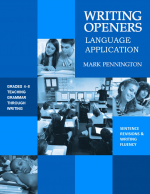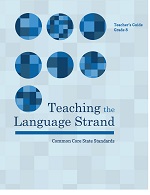Grammar Program Choices
When it comes to grammar, teachers have a wide variety of instructional preferences.
Broadly speaking, teachers agree that standard English grammar and usage needs to be learned, but they disagree on how it should be taught. Some prefer the inductive approach of learning grammar through natural oral language development (Krashen, et al.) or through the process of writing via mini-lessons or learning centers (Graves, Weaver, Calkins, et al.), while others prefer the deductive approach of traditional grammar via rules instruction and practice (D.OL., D.L.R., worksheet-based resources, etc.)
Of course, balanced grammar programs, which attempt to teach grammar in the listening, speaking, reading, and writing contexts do exist and are becoming increasingly popular in many classrooms. Following are brief descriptions of the Pennington Publishing grammar programs, which adopt the latter instructional preference and accommodate the challenges of teaching grammar as a secondary instructional focus in most classrooms. Please click on the title you wish to explore further or click HERE to view the entire grammar collection.
Teaching Grammar and Mechanics Grades 4-8 and High School
Teaching Grammar and Mechanics Grades 4, 5, 6, 7, 8 and Teaching Grammar and Mechanics for High School is its own program.
The grades 4-8 programs feature these components:
*56 language conventions (grammar, usage, and mechanics) lessons with teacher display and student worksheets
*Simple sentence diagrams and mentor texts
*Writing application and formative grammar and mechanics lessons for each 25 minute, twice-per week lesson
*28 biweekly grammar, usage, and mechanics assessments
*Diagnostic grammar, usage, and mechanics tests with corresponding remedial worksheets–each with a formative assessment
The high school program features these components:
*64 quick language conventions (grammar, spelling, and mechanics) lessons for twice-per-week instruction in place of D.O.L. Includes grammar, spelling, and mechanics rule, concept, or skill for each lesson with short practice, simple sentence diagram, mentor text, writing application, grammar cartoon, and three formative sentence dictation assessments
Comprehensive and effective. User-friendly for the novice or veteran grammarian with YouTube training videos.
“Teaching Grammar and Mechanics is the most comprehensive and easy to teach grammar and mechanics program I’ve ever taught. It’s got everything! I’m teaching each grade-level Standard and students are filling in the gaps from previous grade level Standards. This program is written by teachers for teachers and their students. You can tell. Takes no prep and hardly any correction. Both veteran teachers like me and new ELA teachers will really appreciate the scripted grammar lessons.”
Robin M
Writing Openers Language Application
Want to teach grammar through writing? This one’s for you! It’s direct instruction with only two 5-10 minutes openers per week, but it gets the job done… much better than Daily Oral Language or adhoc grammar and mechanics mini-lessons in writers workshop.
These separate grades 4, 5, 6, 7, and 8 programs each provide 56 whole-class, twice-per-week “quick writes,” designed to help students learn, practice, and apply grade-level grammar, usage, mechanics, sentence structure, and sentence variety Standards.
The Writing Openers Language Application lessons are formatted for classroom display and interactive instruction. The teacher reads and explains the Lesson Focus and Example(s) while students follow along on their own accompanying worksheet. Next, the students annotate the Lesson Focus and summarize the Key Idea(s). Afterwards, the students complete the Practice Section (sentence combining, sentence revisions). Finally, students complete the My Own Sentence writing task.
“These quick openers teach grammar in the writing context. So much better than Daily Oral Language!”
Jonathan L.
assessment. Students self-correct their work from the answers and mini-conference with the teacher to review the formative assessment.
“This is an amazing product. It makes individualized instruction a breeze!”
Teaching Grammar and Mechanics Interactive Notebook Grades 4-8
The Teaching Grammar and Mechanics Interactive Notebook Grades 4-8 provides key grammar, usage, and mechanics lessons to address each of the grades 4-8 Language Strand Standards formatted for interactive notebooks (INBs)… culled from the Grammar, Mechanics, Spelling, and Vocabulary and Teaching Grammar and Mechanics programs…
The Teaching Grammar and Mechanics Interactive Notebook Grades 4-8 program will help your students master each of the Common Core grade-level grammar and mechanics Standards. This rigorous, fun, and easy-to-teach interactive notebook is neither a fact-filled collection of boring lecture notes, nor a time-wasting portfolio of art projects.
- Grades 4- 8 lessons aligned to the Common Core (alignment documents included). Note that this is not specifically a grade-level program.
- 64 Lessons designed in the interactive Cornell Notes format with plenty of online links to help students practice. Lessons take 40 minutes, twice per week.
- Students are provided the full note-taking text and write only the examples from the teacher display. LESS time copying and MORE time learning. Students self-correct from answers on the display. Plenty of practice in this program.
- Brief grammar and mechanics sentence dictations to formatively assess whether students have achieved mastery.
- Students read, laugh, and respond to 64 color grammar cartoons by master cartoonist, David Rickert.
- Students use their grammar and mechanics notes to label, color, cut, and glue 3d graphic organizers from easy step-by-step directions. Completed color graphics (the answers) are included to serve as models. No need to create a teacher INB; it’s done for you and for absent student make-up work.
- Minimal preparation and correction. Just copy off two or three student pages and set out the materials. Students self-correct throughout every INB lesson and with the remedial worksheets to learn from their mistakes and save you time.
- Biweekly unit tests with answers assess definition, identification, and application of the grammar and mechanics concepts and skills.
- Diagnostic assessments with over 100 targeted remedial worksheets and online resources. Students complete the worksheet practice, self-correct and edit from the answer booklets, take a brief formative assessment, and mini-conference with you to assess whether students have mastered the Standard.
A terrific collection of grammar and usage, parts of speech, and sentence problems grammar cartoons by ELA high school teacher, David Rickert. Featured in the Teaching Grammar and Mechanics Interactive Notebook Grades 4-8 and Teaching Grammar and Mechanics (for high school) programs…
Grammar/Mechanics, Literacy Centers, Spelling/Vocabulary, Study Skills, Writing




